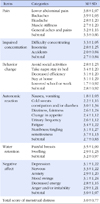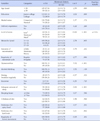Abstract
Purpose
The purpose of this study was to identify menstrual distress, coping method and relief of symptoms among female nurses who worked with 3-shift.
Methods
A total of 185 participants were recruited from November 18, 2011 to January 30, 2012. The measurement included menstrual distress and coping method questionnaire and relief of symptoms. The data were analyzed using t-test, ANOVA, Pearson's correlation coefficients with SPSS 19.0.
Results
The level of menstrual distress was moderate (mean 3.0), and there were significant differences in menstrual distress by age, education, stress, regularity of menstrual cycle. Among the coping methods, coping according to menstrual cycle specific was the most frequently used, followed by active recognizing coping, active behavioral coping, and avoidance coping. Among the degree of symptom relief, symptom relief score was the highest when used coping according to menstrual cycle specific. Menstrual distress was associated with stress, adequate amount of sleep, dysmenorrhea and number of coping method total.
Figures and Tables
References
1. Ahn HY, Hyun HJ, Kim HW. Premenstrual discomforts and coping in university students. J Korean Acad Community Health Nurs. 2005. 16:289–299.
2. Ahn SH, Kim YM. A Study of the perception about menstruation and discomforts of using disposable menstrual pads. Korean J Women Health Nurs. 2008. 14:173–180.

3. Billings AG, Moos RH. The role coping responses and social resources in attenuating the stress of life events. J Behav Med. 1981. 4:139–157. http://dx.doi.org/10.1007/BF00844267.
4. Chiou MH, Wang HH. Predictors of dysmenorrhea and self-care behavior among vocational nursing school female students. J Nurs Res. 2008. 16:17–25. http://dx.doi.org/10.1097/01.JNR.0000387286.30688.5b.

5. Cho YJ. Research on high school girl's menstruation disorder by menstruation diary. 2006. Busan: Dong Eui University;Unpublished master's thesis.
6. Chung MK. A study on the menstrual knowledge, attitudes, symptoms and coping of the high school girls. 1999. Seoul: Ewha Womans University;Unpublished master's thesis.
7. Faul F, Erdfelder E, Lang AG, Buchner A. G*power 3: A flexible statistical power analysis for the social, behavioral, and biomedical sciences. Behav Res Methods. 2007. 39:175–191.
8. Hong KJ, Kim HW, Ahn HY. Menstrual discomfort and dietary habits in adolescents. Korean J Child Health Nurs. 2005. 11:330–339.
9. Hwang WY. Women's menstrual discomforts and coping. Nursing Sci. 2004. 16:41–50.
10. Jahromi NB, Pakmehr S, Hagh-Shenas H. Work stress, premenstrual syndrome and dysphoric disorder: Are there any associations? Iran Red Crescent Med J. 2011. 13:199–202. http://dx.doi.org/10.1016/S0306-4530(03)00097-0.
11. Jun EM. A study on menstrual symptoms, coping and relief of symptoms in female college students. Korean J Women Health Nurs. 2003. 9:161–169.

12. Kim EH, Kim J. Pre-menstruation discomforts experienced by women. Korean J Women Health Nurs. 2001. 7:631–641.

13. Kim HJ. Study on an attitude toward menstruation, perimenstrual symptoms, and coping of nursing students. Korean J Women Health Nurs. 2005. 11:288–295.

14. Lee EH, Kim JI, Kim HW, Lee HK, Lee SH, Kang NM, et al. Dysmenorrhea and menstrual attitudes in adult women. Korean J Women Health Nurs. 2003. 9:105–112.

15. Lee SJ. Comparison of fatigue, job satisfaction and nursing performance between fixed night nurses and rotating shift nurses. 2001. Seoul: Yonsei University;Unpublished master's thesis.
16. Lim YM. Female worker's menstrual discomforts and coping. 2011. Seoul: Ewha Womans University;Unpublished master's thesis.
17. Miyauchi F, Nanjo K, Otsuka K. Effects of night shift on plasma concentrations of melatonin, LH, FSH and prolactin, and menstrual irregularity. Sangyo Igaku. 1992. 34:545–550.

18. Moos RH. The development of amenstrual distress questionnaire. Psychosom Med. 1968. 30:853–867.
19. Park JM. Female worker's attitudes toward menstruation, premenstrual discomfort and coping. 2011. Daegu: Kyungpook National University;Unpublished master's thesis.
20. Park KE, Lee E. A study on premenstrual syndrome and menstrual attitude. Korean J Women Health Nurs. 2001. 7:359–372.

21. Park KR. Stress and menstrual symptoms in high school girls. 1988. Seoul: Yonsei University;Unpublished master's thesis.
22. Park YH, Jeong BS, Kim CY, Lee C. Prevalence of premenstrual dysphoric dysorder and occupational function in a nurse group. J Korean Neuropsychiatr Assoc. 2001. 40:832–841.
23. Collins Sharp BA, Taylor DL, Thomas KK, Killeen MB, Dawood MY. Cyclic perimenstrual pain and discomfort: The scientific basis for practice. J Obstet Gynecol Neonatal Nurs. 2002. 31:637–649. http://dx.doi.org/10.1177/0884217502239207.

24. Smith S, Schiff I. The premenstrual syndrome-diagnosis and management. Fertil Steril. 1989. 52:527–543.
25. Sung MH, Min GO, Jang YJ, Jeon JH. Perimenstrual discomforts, coping and relief of symptoms in female workers. J Korean Acad Public Health Nurs. 2006. 20:57–68.
26. Yoo EK, Kang NM, Kim MH, Kim SA, Kim SJ, Ahn SH, et al. Maternity & women's health care. 2008. Revised. 2nd ed. Seoul: Hyunmoonsa.




 PDF
PDF ePub
ePub Citation
Citation Print
Print






 XML Download
XML Download